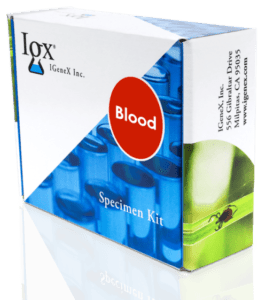• Inexpensive
• An option for initial screening. However, ImmunoBlots and Western Blots are highly recommended in conjunction with these tests.
Test
Lyme Serology IgM
$95.00
IgM antibodies appear early in response to infection, therefore this test may be positive between 2 to 6 weeks after exposure. Though the level of IgM declines over time, the IgM response may persist in patients with prolonged illness and a new IgM response may appear later in persistent or recurrent disease, or from re-infection. This test is recommended approximately 2 weeks after suspected exposure.
The Lyme IgM antibody assay is another serologic test in ELISA format, and it detects the presence of IgM antibodies to B. burgdorferi after exposure to an infected tick. Because IgM antibodies appear early in response to infection, this test may be positive two to six weeks after exposure. But since the level of IgM rapidly declines over time, testing for IgM antibodies too late can cause a missed infection.
A positive or equivocal IgM antibody test must be confirmed by an IgM Western Blot or Lyme ImmunoBlot IgM. The sensitivity concerns mentioned for the IgG/IgM assay also affect this assay.
Tube / Specimen Requirements
1 SST/ minimum volume 0.5mL serum
CPT Code(s)
86618
Sample Report
View
Early Disease
Test MethodologySerology
Available in New YorkYes
Positive: ≥ 1.2 (Confirmatory assays recommended)
Equivocal: ≥ 0.8 to < 1.2 (Retesting in two to four weeks recommended)
Negative: < 0.8 (Indicates IgM antibodies to B. burgdorferi not detected)
- Not generally recommended as a standalone test.
- This test should only be performed in conjunction with Western Blots/ ImmunoBlots.
- Cross Reacting Antibodies:
-Sera from patients with other pathogenic spirochetal diseases such as syphilis, yaws, pinta, leptospirosis, and relapsing fever may give false positive results.
-Sera from patients with mononucleosis or lupus erythomatosis (LE) may also give false positive results.
-In cases where false positive results occur, clinical epidemiological and laboratory workups should be carried out. Active syphilis and Lyme disease can be differentiated by the use of VDRL or RPR tests. In active syphilis, the VDRL and RPR are positive, and in Lyme disease they are not. - Antibiotic therapy given early in the disease may prevent the development of an antibody response. Negative results early in the disease have a low predictive value. Retesting may be warranted if symptoms consistent with Lyme disease persist.
- The evaluation must include all test results, the clinical history presented by the patient, the patient’s exposure to endemic regions for Lyme disease, epidemiological data, and any potential exposure to other spirochetal diseases.
- Positive or equivocal first-tier test results should not be reported until second-tier testing of the specimen is performed using a method that is more specific, such as Western Blot/ ImmunoBlot.
- The use of this assay has not been evaluated for individuals who have received a Lyme disease vaccine.
Related Tests
GET STARTED TODAY!
The first step in getting tested with IGeneX is to order a collection kit. Choose between a Blood, Urine, or Miscellaneous kit.
WHY IGENEX FOR TICK-BORNE DISEASE TESTING?

- CLIA certified in all 50 states
- Long track record of success since 1991
- Offers testing that is nearly twice as accurate as CDC recommended tests
- Tests for all major tick-borne illnesses, including Lyme disease, TBRF, Babesia, Bartonella, and Rickettsia
- Utilizes comprehensive testing methods such as PCR, ImmunoBlots, IgXSpot and FISH
- Has become a nationwide leader in COVID-19 testing due to a relentless focus on customer satisfaction








